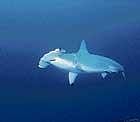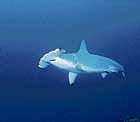

The journals Nature and Current Biology have carried separate reports in the last two weeks on search strategies used in the natural world. One is of a ‘random walk’ approach to improve the quality of scent information from a faraway source, and the other is of the wide placement of nostrils of the hammerhead shark, to help get a clear fix on origin of the odour.
Smell, as it radiates from a source, gets fainter and fainter. Sensing the direction of fastest fall in strength would indicate where the smell is coming from. In real conditions, the smells are from a distance and are quite faint. Add to this the turbulence in the air or sea water, and determining a rate of fall in intensity in some direction, is not practical. Fish that forage in the sea or insects which find others of their kind with the help of smell, have developed methods of polling the neighbourhood and then applying statistical methods to work out where the smell is coming from.
In January 2007, Vergassola, Villermaux and Shraiman reported in Nature a method of rapidly polling the neighbourhood for signs of strong, weak or no signal. The zig-zag motion yields a direction of ‘increasing information’, which directs the manner of polling. This then leads to a direction of ‘increasing’ signal which can then be directly followed in a straight line. The zig-zag action to collect information is called infotaxis and the direct dash along the line of strongest signal is called chemotaxis.
Random motion can take different forms, depending on the kind of behaviour of the organism, through long or frequent steps – be it in the case of colliding molecules of a gas, the movement of prices of stocks and shares, the fortunes of a gambler or the gait of a drunkard. In the case of foraging animals, the Lévy-flight foraging hypothesis holds that Lévy flights are effective where prey is sparse and distributed unpredictably, but that Brownian movement (see box) is good enough when prey is abundant.
Verifying the hypothesis
While studies had shown that the hypothesis is true, recent reviews have questioned the validity of the statistical methods used in verification. The team, whose report is carried in Nature, employed statistical methods known for robustness and accuracy, on a vast animal movement data set, assembled over 5,700 days. The time stamped depth data was collected using electronic tags attached to 55 individuals of 14 species of sharks, tuna, bill fish and ocean sunfish, which prey in the open sea. The Lévy search pattern was found to be prevalent, with some individuals switching to the Brownian motion pattern as they transited from sparse-prey waters to abundant-prey waters.
Pair of nostrils
Fish also smell, not through the organ for breathing like mammals, but by a pair of openings just above the mouth, called nares. They course samples of water, either by pumping action or because the fish is in motion, to sensory organs which detect odours.
The journal Current Biology carries a report of J M Gardiner, Florida and Jelle Atema, Massachusetts, where they find that the pair of nares can act like our own pair of ears, which help us locate a source of sound.
Except when the sound is in front or behind, the sound strikes one ear a split second before it strikes the next.
This slight time lag helps us identify the source of sound. In the case of sound, where there are continuous sound waves, it is actually the slight difference in the progress of the wave, which carries the information, but the difference is still because of one ear being slightly further away.
Gardiner and Atema felt that as water was usually in motion, the concentration of odours was uneven and the direction of higher concentration alone could not be a reliable indicator of the source. In an experiment where a variety of shark (Mustelius canis or smooth dogfish) was exposed to bursts of odour to each nare one after the other, they found that the fish turned towards the odour burst that came first, for time gaps up to half a second, even if the second burst were of higher concentration.
Animals with wider spaced nares would be able to better resolve the source of odours, even at narrow angles and at higher swimming speeds. This may explain the evolution of the hammerhead shark, which has widely separated nasal openings on either side of its wide head.
Deccan Herald is on WhatsApp Channels| Join now for Breaking News & Editor's Picks